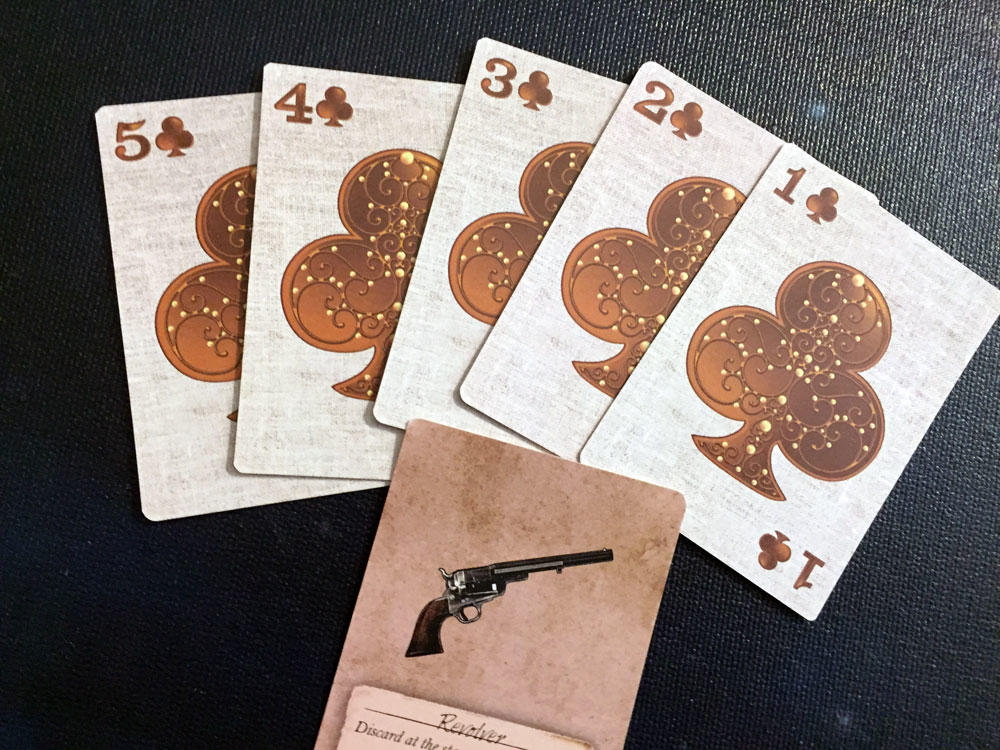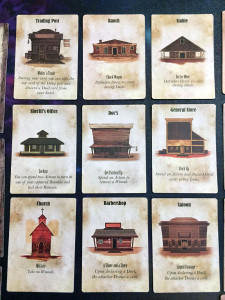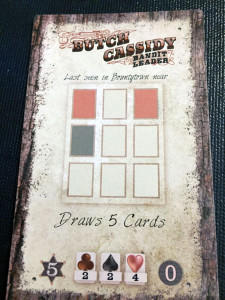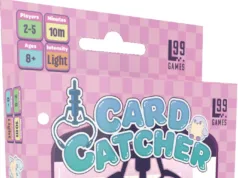
 The Old West is not an overused theme in game design and generally piques my interest when I see a game that carries this theme. Bountytown, designed by Michael Huven-Moore and Kyle Van Winkle oozes the Old West. Its cover displays a kind of Clint Eastwood-esque character brandishing a six-shooter and acting as his backdrop is a wall filled with reward posters. Can you say Deadwood or Tombstone?
The Old West is not an overused theme in game design and generally piques my interest when I see a game that carries this theme. Bountytown, designed by Michael Huven-Moore and Kyle Van Winkle oozes the Old West. Its cover displays a kind of Clint Eastwood-esque character brandishing a six-shooter and acting as his backdrop is a wall filled with reward posters. Can you say Deadwood or Tombstone?
Bountytown was published in 2015 by Victory Point Games and is a game for 3-6 players that states it takes 30-60 minutes to play.
Game Overview:
In Bountytown players are encouraged to collect Bounties. There are desperados that players can duel with in the town in order to capture and increase their Renown. Renown is needed to win the game. Players can also attempt to steal Bounties from other players by dueling. Dueling is resolved using poker-like card-play. Players can buy or obtain one-time use items which can enhance dueling, movement, or hand management.
Game Components:

The Old West theme completely comes out on the cards. The art is reminiscent of tin-type photographs from the period. The characters look like grizzled town-folk from a Spaghetti Western. All of the characters’ eyes are closed which give them that after-death look. It’s creepy for sure. The card text is very readable and easy to discern on how to use them.
The character figures are stand-ups made from VPG’s standard material used for laser-cutting. The face on them matches the art on the character cards.
The rulebook is easy to read and teach from. It is well-formatted and has a table of contents. The rules themselves are well-written and the flow is appropriate for this type of game. There is a great sample of a game turn towards the back of the rulebook.
How to Play:
First a starting player is selected. The rulebook suggests drawing the high card from the Duel Card deck to decide who starts. Play will continue throughout the game in clockwise order.
On each player’s turn, the player can decide to choose to perform 3 actions from the following list and can pick the same action to perform multiple times if desired:
- Move their character to any location in Bountytown
- Use the standard buildings:
- Sheriff’s office – spend 2 actions to turn in a bounty (lock in it from being stolen)
- Doc’s – spend 1 action to heal 1 wound
- General Store – spend 1 to buy items
- Duel a Bounty or another player at their current location
- Reload their hand up to their current hand limit

Dueling to capture Bounties and dueling players to steal bounties is the heart of the gameplay. To Duel a Bounty the active player must be at the either one of the 2 locations where a Bounty is depicted to be on their card. Then the player may discard as many Duel cards as they like from their hand and draw back the same amount from the Duel Card deck. The player then secretly select a hand to play.
Another player at the table draws a number of cards for the Bounty as stated on the Bounty’s card. Both her player and Bounty’s hands are revealed. The winner is determined by who had the highest ranked hand. Hands rank in a poker-like fashion (more on that later). If the player wins, they collect the Bounty Card and place it in front of themselves. If they tie, the player collects the Bounty, but takes a wound. If the player loses, they take a wound and the Bounty escapes and is discarded. Any item the Bounty is carrying is returned to the General Store.
To Duel a Player the attacking player must be in the location where the defending player is. Then the players may discard as many Duel cards as they like from their hand and draw back the same amount from the Duel Card deck. The players then secretly selects a hand to play.
Another player at the table draws a number of cards for the Bounty as stated on the Bounty’s card. The attacking, the defending player, and Bounty’s hands are revealed. The winner is determined by who had the highest ranked hand. Only the two best hands are considered between the 3. There can be ties as well.
If the attacking player wins, they steal the Bounty Card and the defending player takes a Wound. If they tie, the attacking player collects the Bounty, but both players take a Wound. If the attacking player loses, they take a Wound and do not steal the Bounty. If the Bounty wins, they escape and is discarded and both players take a Wound.
At the end of a turn, if any Bounties were dueled, replacement Bounties are drawn to replace the missing ones. Play passes to the player on the left.
During setup there are a number of Bounty cards placed into a draw deck and the Train card is shuffled into the bottom five Bounty cards. When the Train card is drawn the games ends and whoever has the most Renown is declared the winner.

Game Experience:
I appreciate that several elements of Bountytown make it a highly re-playable game. There are 15 characters that you can choose to play. Each of them has a unique special ability that really changes how a player plays the game in order to optimize the benefit.

There are 15 location cards that can be used to randomly construct Bountytown. During setup only 6 of those 15 are used. I have played the game several times and never had the same configuration come up twice. Also each location either affects dueling or allows the players to manipulate their hand from interacting with the Duel Card draw of discard pile.
There are 31 Bounties that represent desperados that the players are attempting to capture and hold onto during the game. Only 16 (3-4 players) or 22 (5-6 players) are randomly drawn during the game. Each Bounty distinctively has its own combination of Renown-value, item count, and base hand and card draw number (used when dueling). Some of the Bounties are even named after real Old West personalities like Butch Cassidy and Belle Starr.
I enjoy tension in a game brought on by changing decisions that one is confronted with from turn-to-turn. In Bountytown, the changing decisions not only occur during your turn, but you may face them because of the head-to-head duels thrown at you by the active player on their turn. There a few game mechanics that aid to hold or heighten the tension.
Each player is limited to dueling players that have at least as much “Renown” as them. At the very start of the game, players have zero Renown and can duel each other as desired, but as soon a player captures a Bounty, thus gaining Renown, they immediately have painted a target on their back. They cannot duel other players, but other players can duel them. That player must be on the defensive protecting their newly-gained Bounty from capture by an opportunistic adversary. Do I want to be that Bull’s Eye? Do I want to lay-low and try to capture low-Renown Bounties?

In Duel resolution, played hands that are the same rank are considered ties and ties are not “broken” by high cards. This was a brilliant design choice in my opinion. It heightens the tension of card-play as the tie always goes to the attacker, but the attacker pays the price by taking a wound. This potential outcome may sway the attacker to attempt to play a hand with greater strength in order to win, but may seriously deplete their hand due to not being able to draw cards after dueling. In player duels, the defender has the advantage where they can bluff (bait) the attacker to attempt to win the hand instead of just tying. The defender knows unless they win the duel outright they are going to take a wound anyway, why not make the attacker deplete as many cards from their hand as possible knowing that they will be able to draw back as many cards as they played during the duel.
The hand management decisions with duel cards are very thought-provoking in this game. The Duel Cards are basically your ammunition and are used to decide who wins the duels. How vulnerable one is to duels by other players/Bounties or how successful one will be as the duel challenger is based on the current strength of hand ranking they have. The poker-like aspect of duel resolution had me guessing and second-guessing about how to balance my hand strength throughout the game. The hand management becomes a tricky exercise in timing when to initiate duels (discarding cards with no redraw), reloading your hand up to its limit, and using cards to buy items.
Having a fifth Gold suit was an excellent idea. Since Gold cards are used to purchase items at the General Store, a player must decide when is it prudent to spend those cards or hold onto them in order to have a greater possibility of obtaining a stronger hand-rank for the next duels. 2 of the top 4 hand ranks must contain a Gold card in them.
Being a long-time poker player I was not a fan of the switch in the hand-ranking in Bountytown. It was not intuitive and I always had to refer to the hand-ranking table in the rulebook. I understand that the hand-ranking in Bountytown is most-likely based on probability of obtaining each rank from 5 suits ranging from values 1 to 5 with 3 cards of each value. I really enjoy Bountytown, but I still did not like having to reprogram my poker-brain each and every time I play it.
At the very least, the game should have supplied a player-aid card for each player as a hand-ranking reference. Since this game consists mostly of cards already, I don’t think adding six more cards would have busted the production budget. I had to make photo-copies of the chart on page 9 for all of the players to use as reference. I believe the back of the rulebook was intended to be a player aid, but in my opinion the background coloring of the hand-ranking chart made it unusable due to being very difficult to read.
Final Thoughts:

I quite enjoy Bountytown as a 3 or 4 player game. It puts players in the position to attempt to take advantage of their strengths and bluff or hide their weaknesses while trying to boost their Renown to win the game and defend against losing duels to the other bounty hunters. The back-and-forth nature of gameplay is challenging and engaging.
At 5 or more players, I can tell you there is going to be quite a bit of down time, especially if duels are occurring between the other players and not you. Yes other players can pull cards for the Bounties when they are involved with duels, but that is not very satisfying. Also with the higher player counts, if any of the players suffer from AP due to the randomness and chaotic nature of the turns, the game length suffers accordingly.
The back-and-forth somewhat random and chaotic nature of Bountytown may not appeal to some gamers, so I would not attempt to play Bountytown with people who do not care for that.
If you’d like to pick up a copy of Bountytown, you can get it for about $35.
Final Score: 3 Stars – A challenging and highly re-playable card game that should hold a place in anyone’s collection as a solid Old West themed game.
 Hits:
Hits:
• Thematic look, feel, and flavor
• Easy to learn and teach
• High replay value
•Challenging and changing decisions from turn-to-turn
• Poker-like card-play
Misses:
• May be too confrontational/chaotic for some
• Potential downtime and long game length at the higher player counts
• Lack of individual player aids (hand ranking reference)






















